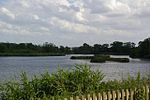River Lark

The River Lark crosses the border between Suffolk and Cambridgeshire in England. It is a tributary of the River Great Ouse, and was extended when that river was re-routed as part of drainage improvements. It is thought to have been used for navigation since Roman times, and improvements to its navigability were made in 1638 and in the early 18th century, when locks and staunches were built. Special powers to improve the river from Mildenhall to Bury St Edmunds were granted by statute (River Lark Act 1698). The upper terminus was on the northern edge of Bury St Edmunds, but a new dock was opened near the railway station after the Eastern Union Railway opened its line in 1846. The navigation was officially abandoned in 1888, but despite this, commercial use of the river continued until 1928. Following an acquisition by the Great Ouse Catchment Board, locks at Barton Mills and Icklingham were rebuilt in the 1960s, but were isolated when the A11 road bridge was lowered soon afterward. It now has one operational lock at Isleham, and can be navigated to Jude's Ferry. Water quality in the river was generally moderate in 2016, although there was a section where the quality was bad, the lowest rating given by the Environment Agency, who monitor English rivers. The river hosts a large population of signal crayfish, an invasive species which has increased as the eel population has diminished.
Excerpt from the Wikipedia article River Lark (License: CC BY-SA 3.0, Authors, Images).River Lark
Ely
Geographical coordinates (GPS) Address Nearby Places Show on map
Geographical coordinates (GPS)
| Latitude | Longitude |
|---|---|
| N 52.4352 ° | E 0.312 ° |
Address
CB7 4UE Ely
England, United Kingdom
Open on Google Maps







